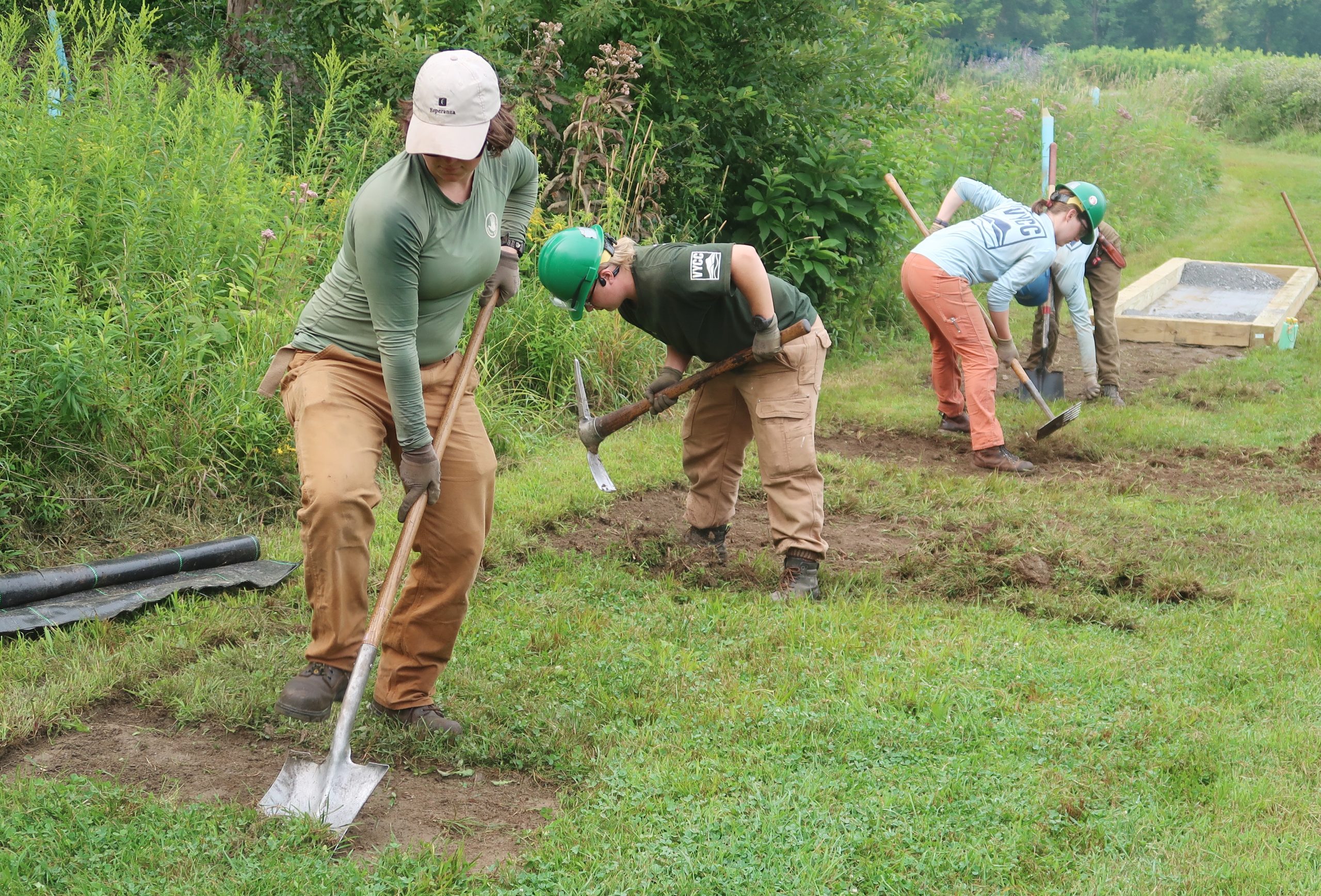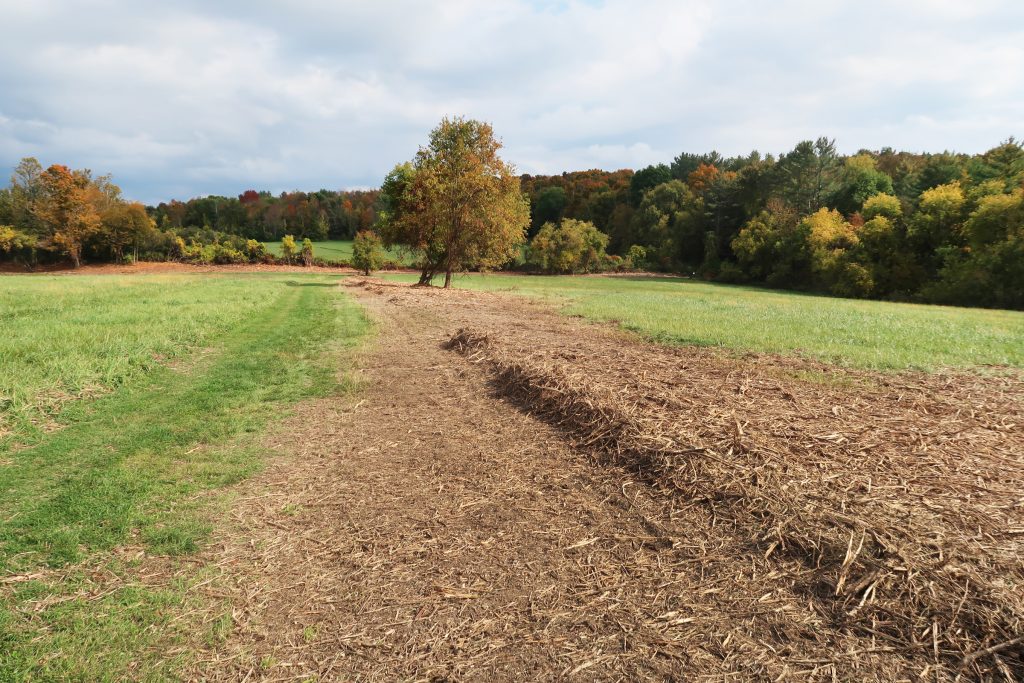The Fund for North Bennington launched its ecosystem resilience project in 2021 by adopting new management plans for The Mile-Around Woods and for its forested land east of Lake Paran. The plans aim to create a breathing space for a healthy habitat’s key species by helping insects, native plants and animals to hold their ground in the face of a tidal wave of invasives, extreme weather and climate change.
This page provides a summary of The Fund’s work to date to support sustainable fields and woodlands, and to educate the public about ecosystem resilience.

2025
Nearing the mid-point of its current conservation management plans, The Fund successfully kept to its schedule in 2025 — despite the drought. We protected hundreds of native saplings, managed invasive re-sprouts, delivered community education, added a rainwater-collection system, improved a popular walking path near The Mile-Around Woods, and continued to protect endangered wildlife species. Federal tariffs and sharply reduced support of agriculture and conservation programs will challenge us, but The Fund remains committed to safeguarding our village’s treasured natural setting.
Invasives control
Invasive re-sprouts were treated by targeted, low-dose, small-nozzle chemical spray. The amounts applied were less than in 2024. The seed bank of invasive plants continues to shrink near The Mile-Around and on Fund land east of Lake Paran. Next year, treatment should taper further with control principally by brush hog and, we hope, by successful competition from native plants.
Planting shelters
Bamboo support stakes for the deer-browse shelters were replaced with rebar after virtually all the stakes were blown down days after planting. After finding several dead birds in the shelters, we capped all shelters with a plastic mesh. (This mesh also dissuades careless humans from dumping trash down the tubes). A shelter will be removed and reused when either a seedling dies or grows out of the 4-inch tube.
Rainwater Collection
After last summer’s drought, we installed a rain-collection system near The Mile-Around to water the vulnerable 600+ seedlings planted last fall. In March, a 130-ft. gutter was installed on the west side of the field barn with downspouts at both ends. The southern downspout feeds two 275-gallon totes set on a flat-bed trailer drawn by a tractor. The totes are filled completely from the barn roof after ½” of rainfall. (This is close to a ton of water). The northern downspout feeds an underground pipe that drains water away from barn’s foundation.
Another dry and hot summer followed a wet spring. A majority of the plantings were watered once in August and once in September. (Not all trees/shrubs could be reached by the gravity-feed system of hoses running from the flatbed height totes to the ground). The totes were completely filled and emptied twice. This system is an excellent resource for the ecosystem resilience project.
Watering the 400 shrubs/trees planted east of Lake Paran last fall was not logistically possible. The USDA inspection forester believes the plantings there will be drought-resistant. He remains impressed by the biodiversity in this 13-acre emerging forest.
Community education
In April more than 100 people benefited from a talk given by a noted Vermont forester (supported by The Fund and the Bennington Master Gardeners.) He was given a complete tour and introduction to The Fund’s resilience project the morning before his talk. He then illustrated key points of his talk with these local examples. (The talk was filmed and can be seen at Ethan Tapper How to Love a Forest starting at minute 3:50)
In addition to many individual visitors, The Mile-Around serves as an outdoor classroom for groups from Bennington College, Vermont Arts Exchange (VAE) and the Village School. College students in two ecology courses completed an ephemeral flower survey (to be repeated in 2026) and learned to connect ecology concepts to a real habitat. They plan in 2026 to complete a survivability survey of the native tree/shrub plantings both at MAW and Lake Paran. One student in 2025 set up a trial deer exclosure study.
The Village School continued to enrich multiple science, art and writing classes via trips to The Mile-Around. VAE’S Wildwood campers were introduced to the variety of species living in the woods and learned how humans help (and harm) the ecosystem.
Ephemerals and Garlic Mustard
The Green Mountain Club and the Bennington Garden Club led numerous walks (with printed guides provided by The Fund) during the flush of spring flowers. It was another beautiful growing season in the Mile-Around! A botanist at Bennington College observed no impact on either number or type of woodland flowers after the careful treatment of invasives the prior summer.
The volunteer Garlic Mustard team again attacked this invasive, helped out this year by Bennington College students. Thirty large garbage bags of this vigorous interloper were hauled away for compost.
Endangered ground-nesting bird fields
Climate change apparently affected the timing of arrival and departure of the bobolink, but nesting, hatching and fledging were again successful. Vermont’s Center for Ecostudies assessed the nesting meadow. They observed that invasive plants too dense for the birds to nest in are moving from the borders and hedges into the delayed-mow fields. They recommend brush-hogging/mulching the field borders annually to slow this process. This will be a new expense for the resilience project.
Intern
Contributions permitted us to hire a half-time intern for eight weeks this summer. She completed the very hot and hard work of de-thatching and mulching around the plantings to help safeguard them from drought. She also wrote informational pieces for the kiosk, monitored bird species and drafted a map of the native tree/shrub plantings.

2024
With the “no corn” farming policy now in place, the fields are managed only for cool-season grass hay. Our farmers now use manure (rather than commercial fertilizer) to the extent feasible.
Invasives
To further exhaust the considerable seed bank of invasive plants, regrowth was permitted for a year after initial treatment in 2022. In 2024 the areas were brush-hogged or treated with low-dose herbicide. (This was a targeted, virtually zero-drift backpack spray method with an application rate just 4 percent of that typically applied to prepare a field for corn.) Removing these re-sprouts greatly increases the survival chances for native trees and shrubs. After all the work accomplished in the last three years, less intensive methods will be required in the future to control invasive species.
Native tree and shrub planting
More than 600 dormant native trees and shrubs were planted in the fall of 2024 along The Mile-Around Woods’ former hedge rows and perimeter. At maturity these saplings will provide nutritious food and safe nesting sites (unlike the previous invasives-only hedges) and will function as wildlife travel corridors to and from woodlands. Given the persistent deer browsing and damage to prior (unprotected) plantings, we concluded that the saplings should remain caged for several years until they are well-established.
Responding to interest in silviculture expressed at a community meeting in 2022, the plantings include a grove of blight-resistant chestnuts that will be “adopted”, and studied, by children at The Village School. A demonstration site of heartnut trees were also planted as an experiment to assess the impact of climate change on different tree species.
More than 400 natives were planted in what was a 13-acre impenetrable honeysuckle thicket near Lake Paran. Native and non-native species in both areas include white pine, serviceberry, hazelnut, elderberry, paper birch, persimmon, quaking aspen, red oak, dogwood, shagbark, sugar maple, heartnuts, butternuts, and chestnuts.
Thanks to the Whipstock Hill Preservation Society for their generous support. Thanks also to the following for their assistance in 2024: North Point Forest Farm Supply; Long View Forest; Bennington College student volunteers and Dept. Grounds and Maintenance; Bonnie Lea Farm; Bottesi Trucking; and many community volunteers.
2023
More mulching, more planting and weakening of the long-lived seed bank. In 2023 we started to stifle the long-lived and enormous invasive plant seed bank while encouraging growth of native species. In addition to mulching more mature invasives and planting hundreds of native shrubs and tree in new areas, we allowed the hidden invasive plant seeds to germinate. This helped us to find and remove them in 2024. A new kiosk was set in place with a new map to share information and news about The Mile-Around Woods.

2022.
Mulching of mature invasives and impenetrable honeysuckle. Two-million feet cubed (a volume comparable to 50 railroad cars) of seed-producing, mature invasive plants were shredded by the “Brontosaurus” — a giant mulching machine. Work occurred near The Mile-Around Woods and on 13 acres east of Lake Paran. This was the first step to restore an ecosystem with the plant, shrub and tree diversity needed to sustain local wildlife. Tick habitat was drastically reduced and the no-waste method resulted in organic matter that will break down to benefit the soil and limit erosion.
2021.
10-year plans approved. Consultations with multiple conservation experts (ecologists, The Nature Conservancy, Natural Resource Conservation Service, Vermont Center for Ecostudies, the Vermont Land Trust, regional Conservation Districts et al.) helped guide the prescriptions in our ten-year management plans. We planted 220+ native shrubs in the Monarch Meadow, and identified and mapped severe invasive species infestations found throughout the property. The “big five” are buckthorn, bittersweet, burning bush (euonymus), barberry, and multi-flora rose.
More about The Fund’s conservation work may be found here.